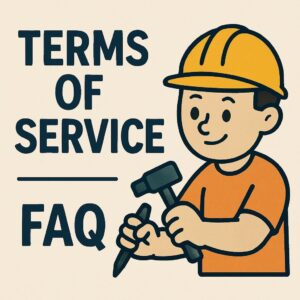
Terms
FAQs
Welcome to crafyourquit.com FAQs.
Your Ultimate DIY Hub of information, skills and inspiration.
This FAQ is designed to guide you through your journey, from your first project to potentially turning your passion into profit. Your safety and growth are our top priorities.
Please read the Disclaimer section carefully before using any information on this site.

Section 1: Safety First – The Non-Negotiable Rule of the day.
Q1: Why is safety the first thing you talk about?
DIY is an incredibly rewarding venture, however, it involves inherent risks with tools, materials, fire, and electricity. A successful project is the particular one completed without an injury. We prioritize safety all the time to ensure you can enjoy DIY for many years to come.
Q2: What are the absolute essential safety items I need?
At a minimum, you must have:
- Eye Protection: Safety glasses for any task involving heat and fire, debris, chemicals, or force.
- Hearing Protection: Earplugs or earmuffs when using loud power tools like saws or sanders.
- Respiratory Protection: Dust masks (N95) for sanding or painting, and respirators for chemicals, solvents, or spray foam.
- Gloves: Task-specific gloves (e.g., heavy-duty for handling lumber(timber), stones or rocks, welding, nitrile for chemicals).
- First-Aid Kit: Always have a well-stocked kit easily accessible and visible. In addition learn First-Aid as a skill since it will supplement your approach to any particular injury whilst working with your colleagues.
- Firefighting equipment: This is vital as you establish an organized safe working environment. These are not limited to water horses, fire extinguishers and fire blankets with classified and coded cylinders placed at strategic positions while minding obstructions so that you balance between, visibility, accessibility and their likely becoming an every day hazard item while working.
Q3: How do I safely work with power tools?
- Read the Manual: Every tool is different in terms of its ability, power input and output, features like handles, blades excreta.. Know its specific safety features and warnings that come with it.
- Unplug Tools: Always unplug tools when changing blades, bits, lubricating or refilling oil/fuel; or making adjustments. Any running machinery while conducting these activity can lead to severe injuries or can be fatal.
- Remove Distractions: No loose clothing, jewelry, blurring elements on safety glasses or on your eye-spectacles, long finger nails, or long hair near moving parts. Focus entirely on the task with no distractions all.
- No taking of alcohol whilst working within the workshop environment especially with running machines and sharpened blades or tools.
- Use the Right Tool: Never force a tool to do a job it wasn’t designed for. For example why use a wood blade on a metal material?
- Keep Workspace Clean: A cluttered area is a tripping hazard and increases the risk of accidents.
Q4: What should I know about electrical safety?
- Always turn off the power at the circuit breaker before working on any electrical fixture, outlet, or switch.
- Use a voltage tester to double-check that the power is off before touching any wires.
- If you are unsure about any electrical project, stop and consult a licensed electrician. There are basic electrical courses that come in handy and the ‘University of YouTube’ will guide you through free of charge.
Section 2: Skills & Learning – Building Your DIY Foundation
Q5: I’m a complete beginner. Where should I start?
Welcome! Start with low-risk, high-reward projects that build confidence.
- Ideal Starter Projects: Building a simple planter box, painting a room, assembling flat-pack furniture, installing shelving, or basic home maintenance like unclogging a drain. Besides, any idea that strikes your brain, work it through without postponing or fearing what ‘they might say’ – after all what do they know anyway?
- Focus on mastering fundamental skills: measuring accurately, drilling and cutting straight, basic sanding/finishing, and choosing the paint/painting correctly. Use of square ruler, tape measure, spirit level, and clamps will enhance your output. Above all minding your safety!
- Engage with other DIYers: From the university of YouTube, we have a tone of DIYers teaching everyday on how to develop and commercialize stuff. If necessary choose a mentor.
Q6: How do I choose the right project for my skill level?
Our projects are tagged with a difficulty level:
- Beginner: Requires minimal tools, simple steps, and no complex techniques coupled in a learning mindset.
- Intermediate: Involves multiple steps, more specialized tools (e.g., a circular saw), and some prior experience. You have learnt a few skills and techniques and you require upskilling, get into the right forums without delay.
- Advanced: Requires professional-grade tools, in-depth knowledge of techniques, and a high understanding of structural integrity and safety. In this status you are a consultant. If you have not created content for YouTube, TikTok and Instagram you’re losing big time!
Q7: Where can I learn the techniques I see in your tutorials?
- Our Website: We have a dedicated “Skills & Techniques” section with articles and videos on everything from “How to Use a Drill” to “Advanced Joinery.” etc. We will also invite other Gurus to share their ideas.
- Video Tutorials: We gather and create detailed video guides for most projects, allowing you to see the process in action.
- Community Forum: Ask questions and get advice from our community of DIYers of all skill levels.
Section 3: Self-Development & Awareness – The DIY Mindset
Q8: How can DIY contribute to personal growth?
DIY is more than building things; it’s about building character.
- Problem-Solving: Every project presents puzzles to solve, enhancing critical thinking.
- Resilience: You will make mistakes. Learning to fix them teaches patience and perseverance.
- Confidence: There’s no feeling quite like using something you built with your own hands.
- Mindfulness: Focusing on a manual task can be a form of active meditation, reducing stress.
- Keep off drugs and excessive consumption of alcohol.
Q9: How do I deal with frustration, errors and mistakes?
Mistakes and omissions are not failures; they are learning opportunities, learn to include them in your manuals of engagement.
- Take a Break: Relax ands tep away if you feel frustrated. Return with a fresh perspective. Every time you return, you have a better vision and ideas into the project.
- Ask for Help: Use our forums or other online communities. Everyone was a beginner once. Consultations and asking for help is not a sign of weakness.
- Adapt and Improvise: Often, a “mistake” can lead to a unique and creative design solution you hadn’t originally considered. With the enhancement arriving from critical thinking, this opens a whole new world you never saw in your idle status.
- Be happy: Celebrate every new achievement and small gains; in the journey of DIY many of us are here, and are waiting for the opportunity to celebrate every day.
Q10: How can I become more aware of my capabilities and limits?
- Develop an affinity: You must start from where you are and progress with something you like more and more everyday
- Honest Self-Assessment: Before starting, honestly evaluate if you have the required skills, tools, time, and physical ability.
- Frequent practice: The more you do the more you realize the potential of that ‘crafty you’, unlock it along the way because there is no defined path or formular. Every DIYer has had his/her own path with a load of basket full of ups and downs.
- Engage criticism: In every environment there are critics who help shape ideas in the right direction. Embrace them with an open heart but also learn when to bow out safely without destructions.
- Know When to Call a Pro: Very important! Some projects, especially those involving major structural changes, plumbing, or high-voltage electrical work, are best left to licensed professionals. There is no shame in asking or hiring an expert for a clean finished job; above all you’ll learn the easy way!
Section 4: Income Generation – Turning Passion into Profit
Q11: Can I really make money from DIY?
Yes! Many people turn their DIY skills into a side hustle or even a full-time business. However, it requires treating it like a business venture, not just a hobby. If your aspiration is to escape the Rat-Race, here you are; about to arrive in your destination; call it like it is and it will happen.
Q12: What are some ways to generate income?
- Sell Your Projects: Create custom furniture, home decor, or crafts to sell on platforms like Etsy, at local markets, or through social media.
- Freelance Services: Offer your skills for hire for tasks like painting, furniture assembly, minor home repairs, or mounting TVs.
- Content Creation: Start a blog, YouTube channel, TikTok, or Instagram account documenting your projects. Income can be generated through ads, sponsorships, and affiliate marketing; and this is where I am.
- Teaching Workshops: If you are into teaching business host local or virtual workshops to teach others your skills.
Q13: What are the first steps to selling my DIY projects?
- Find Your Niche: What can you make that is unique and in demand? – We said on Q10 Develop an affinity! For example You cannot struggle with metalworks while you know your best bet is on cement/clay crafts.
- Cost Calculation: Accurately calculate your material costs, time, and overhead to ensure you price your work profitably.
- Legal & Tax Awareness: You may need to register a business name, obtain a license, and track income for tax purposes. Consult a local professional for advice.
- Build a Portfolio: High-quality photos of your work are essential for marketing.
Section 5: Disclaimer – Please Read Carefully
Important Notice:
The information provided on CraftYourQuit.com is for general informational, inspirational and educational purposes only. All content, including text, images, videos, and tutorials, is created and published in good faith.
However, we must state:
- No Professional Advice:
We are not licensed contractors, electricians, plumbers, or structural engineers etc.. The information on this site is not a substitute for professional advice, diagnosis, or instruction. You are solely responsible for determining the appropriateness of a project for your skill level and for ensuring you comply with all applicable local laws, building codes, permit requirements and any environmental assessment & impact.
- Assumption of Risk:
DIY projects involve inherent risks, including but not limited to risk of property damage and (sometimes environmental damages), personal injury, or death. By choosing to undertake any project you find on this site or else where, ‘you voluntarily assume all known and unknown risks associated with the project.’ You are solely responsible for your safety, the safety of your helpers, and the safety of your property and the surrounding environment.
- Accuracy of Information:
While we strive to provide accurate and up-to-date information, we make no warranty or representation regarding the accuracy, adequacy, completeness, legality, reliability, or usefulness of any information provided. Techniques, tools, and materials change over time. It is your responsibility to research and ensure the information is appropriate for your specific situation.
- No Endorsement:
Mention of specific products, tools, or services on our site does not constitute an endorsement or recommendation unless explicitly stated.
- Limitation of Liability:
Under no circumstances shall CraftYourQuit.com, its owner(s), author(s), or affiliates be liable for any direct, indirect, incidental, consequential, or special damages arising out of or in any way connected with your access to or use of the information on this website, including any damage or injury caused by your reliance on such information.
By using this website, you acknowledge that you have read, understood, and agree to this disclaimer and our Terms of Service.
Happy (and Safe) crafting!
CraftYourQuit.com


